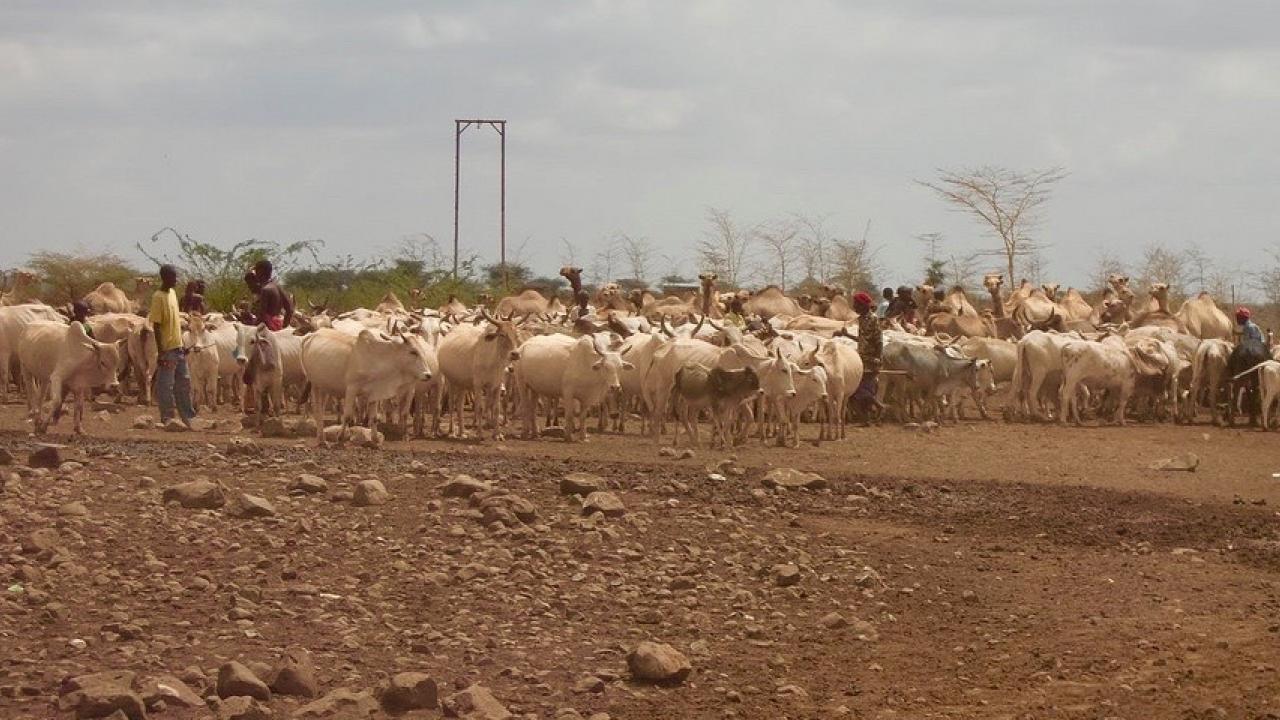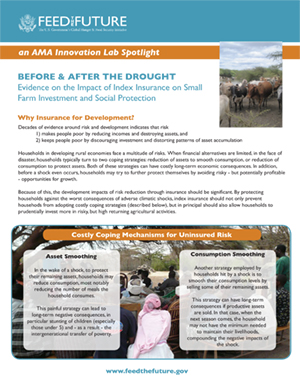
Households in developing rural economies face a multitude of risks. When financial alternatives are limited, in the face of disaster, households typically turn to two coping strategies: reduction of assets to smooth consumption, or reduction of consumption to protect assets. Both of these strategies can have costly long-term economic consequences. In addition, before a shock even occurs, households may try to further protect themselves by avoiding risky - but potentially profitable - opportunities for growth.
 Because of this, the development impacts of risk reduction through insurance should be significant. By protecting households against the worst consequences of adverse climatic shocks, index insurance should not only prevent households from adopting costly coping strategies (described below), but in principal should also allow households to prudentially invest more in risky, but high returning agricultural activities.
Because of this, the development impacts of risk reduction through insurance should be significant. By protecting households against the worst consequences of adverse climatic shocks, index insurance should not only prevent households from adopting costly coping strategies (described below), but in principal should also allow households to prudentially invest more in risky, but high returning agricultural activities.
Index-Based Livestock Insurance (IBLI) in Northern Kenya
The arid pastoral regions of Northern Kenya are an archetype of risk and coping in the absence of financial markets. Shocks are severe, financial instruments are sparse, and poor households are left with few options. IBLI was rolled out in 2009 as part of a rigorous impact evaluation. The 2011 drought created the opportunity to really observe the impact of insurance on household coping and well-being.
On average, AMA Innovation Lab researchers find that after the drought, insurance leads to a 36 percent decrease in sales of remaining livestock, and a 25 percent reduction in household meal consumption. However, prior research on poverty dynamics made researchers dig a little deeper into how insurance may have impacted certain types of households differently.
Previous evidence suggests the existence of a critical asset threshold, below which households become enmeshed in chronic, seemingly inescapable poverty. Without insurance, households above a critical threshold tend to smooth consumption by selling assets; insurance leads to a 70 percent drop in asset sales for these less poor households. Households below this critical threshold tend to smooth assets by reducing meals; insurance leads to a 62 percent reduction in the use of meal reduction as a coping strategy for these poorer households.
Two-Trigger Area Yield Contract in Mali
Cotton farmers in West Africa often pursue a diversified production strategy, growing their own food, as well as some (highly profitable) cotton. Though loans are available, the consequences of default are severe due to the joint liability and the informal collateral used. Farmers report growing less cotton than they otherwise would, or that they reduce their exposure to financial risk by investing less in cotton. As a result, farmers are poorer than they need to be given the economic opportunities available to them.
Area yield contracts offer strong insurance value compared to other indices, but the trick is identifying the right geographic area on which to base calculations. Too small an area can create moral hazard, and too large an area reduces the quality of the insurance. By using two triggers, one at each level, a balance can be found. Indeed, researchers who tested this had encouraging results.
Insured farmers increased the area of cotton cultivated by 55 percent. In addition, insured farmers increased their use of loans for productive investments by 34 percent and increased their use of productive inputs by more than 50 percent against the control. Insurance gave them the confidence and peace of mind to increase productive investments before the drought.
Designing Comprehensive Insurance to Maximize Development Impacts
The studies described above demonstrate that index insurance can not only provide real protection to both consumption and assets, as in Kenya, but can create a risk reduction dividend, as in Mali. Too often, however, policy and program design is segmented. Insurance is either thought of for social protection for poor, subsistence households, or as a tool for economic advancement for more market-oriented farmers. These two positions, however, are not fixed.
If development organizations do not design a more comprehensive approach to index insurance, we may miss an opportunity to use insurance as a tool for upward mobility, moving household from subsistence to commercial. More work needs to be done to develop comprehensive designs that allow poorer households to insure marginal risks that they might then be able to take on once they are insured. This can maximize the development impacts of this financial innovation.
This report is made possible by the generous support of the American people through the United States Agency for International Development (USAID). The contents are the responsibility of the Feed the Future Innovation Lab for Assets and Market Access at UC Davis and do not necessarily reflect the views of USAID or the United States Government.
